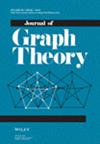On k -Edge-Hamilton-Connected Line Graphs
IF 1
3区 数学
Q2 MATHEMATICS
引用次数: 0
Abstract
We say that a graph is -edge-Hamilton-connected if has a Hamilton cycle containing all edges of for any with such that is a linear forest. In 2012, Kužel et al. conjectured that every 4-connected line graph is 2-edge-Hamilton-connected, and proved that it is equivalent to Thomassen's conjecture stating that every 4-connected line graph is Hamiltonian. In this paper, we prove that for every -connected line graph is -edge-Hamilton-connected.
关于k边-哈密顿连通线图
我们说一个图G是k边汉密尔顿连通的,如果G + M存在一个包含M的所有边的Hamilton环Y∣x,y∈V (G)}满足∣M∣≤k,使得M是线性的森林。2012年Kužel等人推测了每一个4连通的线形图都是2边汉密尔顿连通的,并证明了它等价于Thomassen关于每一个4连通的线形图都是汉密尔顿连通的猜想。在本文中,我们证明了对于k≥2,每(k +5)连通线图是k边哈密顿连通的。
本文章由计算机程序翻译,如有差异,请以英文原文为准。
求助全文
约1分钟内获得全文
求助全文
来源期刊

Journal of Graph Theory
数学-数学
CiteScore
1.60
自引率
22.20%
发文量
130
审稿时长
6-12 weeks
期刊介绍:
The Journal of Graph Theory is devoted to a variety of topics in graph theory, such as structural results about graphs, graph algorithms with theoretical emphasis, and discrete optimization on graphs. The scope of the journal also includes related areas in combinatorics and the interaction of graph theory with other mathematical sciences.
A subscription to the Journal of Graph Theory includes a subscription to the Journal of Combinatorial Designs .
 求助内容:
求助内容: 应助结果提醒方式:
应助结果提醒方式:


